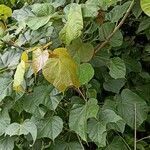Deciduous trees, up to 15 m tall. Branchlets gray-black when desiccate, minutely gray puberulent. Petiole 10-15 cm; leaf blade broadly cordate, 17.5-25 × 18-20 cm, thinly leathery, both surfaces sparsely yellowish stellate puberulent, basal veins 5-7, veinlets prominently raised on both surfaces, nearly parallel, base deeply cordate, apex 3-5-lobed, middle lobe ca. 5 cm, apex obtuse, lateral lobes ca. 3 cm. Inflorescence cymose-paniculate, up to 7 cm, densely orange-red stellate puberulent. Pedicels 4-5 mm, puberulent. Calyx funnel-shaped, base nearly cuneate, ca. 20 × 7-8 mm, apex 5-lobed, abaxially densely stellate puberulent with orange hairs, adaxially densely puberulent, lobes ovate-triangular, ca. 4 mm, apex acute. Male flower: androgynophore 10-12 mm, stellate puberulent. Female flower: ovary 5-locular, nearly separated, glabrous. Style short; stigma curved outward. Follicle stalked, red or purple when mature, foliaceous, tongue-shaped, 5-7 cm, 2-4-seeded, with apparent venation. Seeds black, globose, ca. 6 mm in diam. Fl. Mar-Apr.
More
A tree 8-20 m tall. It is straight and loses its leaves during the year. The trunk is covered with thick, scaly, ash-coloured bark. The crown has spreading branches. The leaves are crowded at the ends of branches on slender stalks. The leaves are 10-20 cm long by 8-30 cm. There are 3-5 pointed lobes. The young leaves are downy. The flowers are bright orange red. They occur while the tree is leafless. The flowers and their stalks are covered with downy hairs. The fruit look like an orange coloured leaf. There are 1-2 seeds on the edge.

